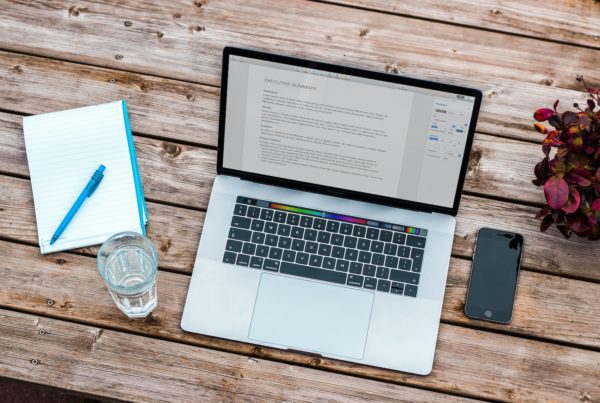As a fashion designer, your portfolio is an essential and powerful tool for showcasing your skills and style to potential employers and clients. It’s important to get the layout right and present your work in a clear and organized manner so that it’s easy for people to understand your thought process and aesthetic. We’ve laid out some of our top tips for laying out a fashion design portfolio, to help you give it your all in an interview.
Summary Page
Start your portfolio with a summary page. Remember, this is going to be the first thing people see, so use it to introduce yourself. The summary page will have your name and job role, and can also state your job title, such as “Womenswear Designer”. Add a short amount of text highlighting your style and strengths. The design of the page should succinctly express your aesthetic and the overall theme of the portfolio.
Laying out the Project Pages
Let’s think about the layout of your portfolio, it’s important here to show the viewer your thought process. The design process is a journey, one of inspiration, creativity, and commercial awareness. So, you want to ensure each project shows these elements in an organised and natural progression.
Separate projects into sections and start each section with a coversheet that has the title of the project and a visual style that reflects the project to follow. This will introduce the viewer to the project and give them a sense of what’s to come; like leading them on a journey through your creative process from the start.
Your Research
Now, let’s look at how each project should be laid out. Start with a research page for each project, to document the sources of inspiration for your designs. Research is an important part of the design process as it’s where your ideas came from that shapes your work and adds meaning to the final designs.
A research page can include information and photos from inspiration trips, images of brands or designers that have inspired you, cultural events you have attended, and popular media sources that have influenced the work.
Another result of showing your research is that it shows you’re passion and commitment to staying up-to-date and engaged in the fashion industry, as well as your versatility in discovering new ideas and sources of inspiration.
The Moodboard
A natural progression from your research page is a moodboard to visually showcase the key elements from your research that you feel will translate well into your designs. The moodboard will be a strategically curated selection of images, colours, and other visual elements to create a refined theme for your project. These can be photographs, drawings, magazine clippings, swatches of fabrics, colours, shapes, construction details, textures, and other visual elements that you plan to use in your final designs.
It’s important to take a step back and look at your mood and ensure that it tells a cohesive story. Sometimes this can be done easier with fewer elements, so as not to confuse the message.
Getting down to the details
Once you have established the overall direction and aesthetic for your project through your moodboard and research, it can be helpful to create a component page that showcases the specific fabric and colour palates, trims, and construction details that you will be using in your designs.
It’s important to add this step as it will show how you can translate research into actual design elements, as well as establish a reference to ensure consistency through the final collection.
Showcasing with flare
Next, it’s time to use the moodboard and components to get designing and show off your key designs with creative illustrations. Illustrations can be created by hand sketching or using digital media; it’s becoming increasingly beneficial for designers to learn how to design in 3D.
However you illustrate, it’s a chance to show your creative flair, so the media you use is only limited by your imagination and the type you use could even be something that relates to the theme. Illustrations are fun to create but they also serve a purpose other than just being expressive images to look at.
When creating your illustrations, consider the target consumer of your project; their lifestyle and aesthetic, and the context in which your designs will be worn or used, and include elements in your illustrations that reflect this context. This way, your illustrations will give your viewers a more complete understanding of your designs and help them to visualize their real-life context.
Bringing it together in the Range Plan
Now it’s time to add a range plan, featuring flat illustrations of your designs to show the overall pieces in the project and how they work together as a collection.
Flat illustrations are different to creative illustrations in that they tend to be more proportionally drawn to give a greater sense of the actual silhouette and shape of the garment. Think about how you will be presenting the collection in range meetings to, often, less creative personnel in the business. They want to see how your creativity has been translated into an appealing commercial range.
When creating a range plan, be sure to include fabric swatches or scans, as well as colours from your initial colour palette, to show cohesion across the range and how pieces can work together. Highlighting any unique details of each design can also help draw attention to specific features and elements of your work that might also pull the whole collection together.
Ultimately, a range plan helps to demonstrate your ability to create cohesive and well-planned collections. It also helps viewers to understand the breadth and scope of your work as well the commercial potential of your skills.
Getting Technical
It’s often forgotten, but it is essential to include working drawings in your portfolio. Also known as technical drawings, these are detailed, outlined illustrations that are clearly labelled and highlight specific construction details. These drawings typically include information on seam types, seam finishes, hemlines, and other details that are important for the manufacture of a garment. Each project typically shows your working drawings for that collection, however, they can sometimes be shown in their own section in your portfolio.
Ultimately, it’s important to have them as they demonstrate your technical knowledge and attention to detail, as well as show that you are capable of creating clear and accurate instructions for manufacturers. This can be especially helpful in demonstrating your ability to translate your creative ideas into workable product that can be followed by others.
The Specifics
The next step is also important in proving your commercial awareness, and that is a measurements page. Information on the overall garment size and specific details like zip lengths can be useful for demonstrating your technical skills and ability to create clear instructions for manufacturers.
Working drawings and measurements, together form an important part of what is known as a Tech Pack, important tools in the design process that help to ensure that garments are properly sized and constructed. Getting tech packs as accurate as possible also ensures samples are kept to a minimum and the development time between design and production is as quick as possible.
Getting real – with photoshoots
If you have any physical prototypes of your designs, finish your project by showcasing them on a photoshoot page. If your designs have been featured in media campaigns, be sure to include these in the showcase as well. Visual examples of real designs can be a helpful way to bring your work to life and give viewers a sense of the fit, feel, and overall aesthetic of your work. Photographs of your actual made designs will show how they look and function in the real world and commercial context.
When adding photos or clippings of work or media appearances, be sure to provide some context and background information, and include any relevant details that will help to give viewers a sense of the significance of your work.
We hope this helps you take a fresh approach to putting together a portfolio. A good layout will help you present well in interviews and provide hiring managers with a complete understanding of not only your creativity but also your commercial and technical awareness.





